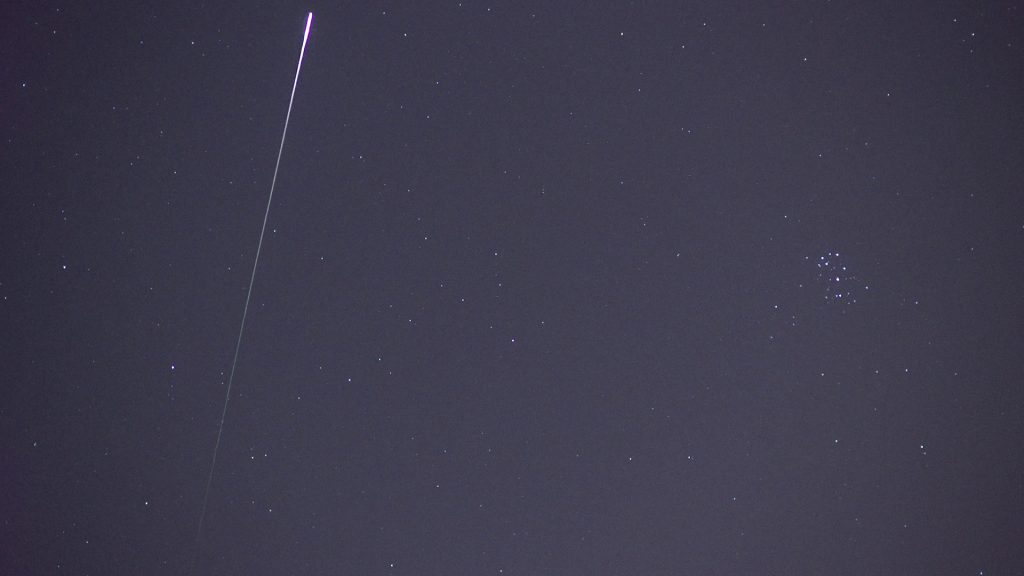2023 December 10
Dark Skies for the Geminid Meteor Shower this December
The Geminid meteor shower is expected to reach maximum activity sometime in the afternoon (UK time) of Thursday, December 14 this year. It is the richest of the regular annual meteor showers at the present time. Under good observing conditions the shower produces plenty of bright meteors, with rates easily exceeding those of the August Perseids for a 24-hour interval centred on the peak. The shower is certainly rewarding for any observers prepared to brave the winter wind, cold and damp.
Although active earlier in the month, from December 9 until maximum there is a steady rise in activity from night to night and then a steep rise in the 24 hours immediately before the peak. The Geminid maximum is quite broad and respectable Geminid rates may be expected throughout the nights of December 13/14 and 14/15. The really good news is that the peak coincides with a 2-day old Moon so there will be no interference by moonlight at all this year.
 Plot courtesy of the Global Meteor Network averaged over multiple years showing the slow rise, peak at around 261.9 degrees solar longitude and rapid fall.
Plot courtesy of the Global Meteor Network averaged over multiple years showing the slow rise, peak at around 261.9 degrees solar longitude and rapid fall.
An analysis by Alex Pratt of 1,447 multi-station Geminids recorded in the RMS and UFO data of observers in the NEMETODE video meteor network during December 2022 showed that peak activity occurred at a solar longitude (2000.0) of ~261°.9, equivalent to around midday on December 14 this year and during daylight hours from the UK. This is somewhat earlier than the usually quoted timing of the peak (at solar longitude 262°.2), but agrees with the GMN (Global Meteor Network) data for 2022. In any case it means that observers in the UK will probably miss the actual peak this year, but very respectable rates will be observed in the pre-dawn hours on December 14 and during the evening that same day.
Alex Pratt’s analysis showed that Geminid meteors may be recorded from about 17:15 UT onwards in the early evening and up to 07:00 UT in the morning. The radiant of the Geminid shower (at RA 07h 34m, Dec +32.3o, just north of the first magnitude star Castor) rises early in the evening and reaches a respectable elevation above the horizon (> 40o) well before midnight, so observers who are unable to stay up late can still contribute very useful watches. However, the pre-dawn hours of Thursday, December 14 are likely to yield the greatest observed Geminid activity, because the radiant is then high in the sky and rates are rising towards the peak. December nights can be quite chilly, especially in the early morning hours when activity is likely to be highest, so wrap up well with plenty of layers of warm, dry clothing and make sure that you wear a hat, gloves, thick socks and sensible waterproof footwear.
Past observations have shown that bright Geminids become more numerous some hours after the rates have peaked, a consequence of particle-sorting in the meteoroid stream. This means that the early evening hours of December 14 may well yield the brightest members of the shower. In addition, Alex Pratt’s studies showed that in 2022, GMN data revealed a noticeable ‘shoulder’ in the activity curve as the rates declined, at a solar longitude (2000.0) of 262°.5, equivalent to just after 02:00 UT on December 15 this year and it will be interesting to see if this feature is observed again. Thereafter, there is very steep decline in Geminid rates, suggesting that the meteoroid stream has a sharp trailing edge where it intersects Earth’s orbit.
As with any meteor shower, when observing the Geminids it is best to look at an elevation of 50o (about the same altitude as the Pole Star from southern parts of the UK) and 40-50o to either side of shower radiant, rather than looking directly at the radiant itself, although Geminid meteors may appear in any part of the sky.
Geminid meteors enter the atmosphere at a relatively slow 35 kilometres per second, and thanks to their robust (presumably more rocky than dusty) nature tend to last longer than most in luminous flight. Unlike swift Perseid or Orionid meteors, which last only a couple of tenths of a second, Geminids may be visible for a second or longer, sometimes appearing to fragment into a train of ‘blobs’. Their low speed and abundance of bright events makes the Geminids a prime target for imaging.

A Geminid passes near to the Pleiades. This is a 1/25 s exposure using an 85mm, f/1.2 lens and a Sony A7s Camera.
Get Involved
The BAA’s visual meteor report forms, available as downloads in both PDF and Excel formats, enable observers to record the details of each meteor seen. These include: time of appearance (UT); apparent magnitude (brightness); type (shower member, or random, ‘background’ sporadic); constellation in which seen; presence and duration of any persistent train. Other notes may mention flaring or fragmentation in flight, or marked colour. Watches should ideally be of an hour’s duration or longer (in multiples of 30 minutes). Observers are reminded to carefully record the observing conditions and the stellar limiting magnitude. Wrap up warmly and enjoy what should be a great show!
By whatever means you observe the Geminids this year, please submit your results to the BAA Meteor Section via meteor@britastro.org.
Dr John Mason Director,
BAA Meteor Section
email: meteor@britastro.org
2023 December 09
| The British Astronomical Association supports amateur astronomers around the UK and the rest of the world. Find out more about the BAA or join us. |
